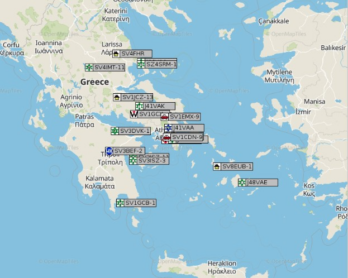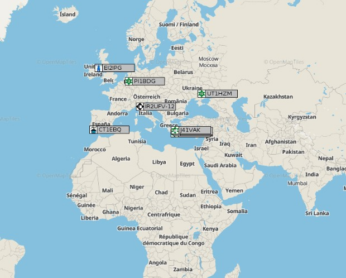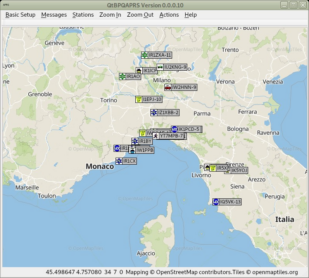Tutorial
Advantage of Winlink Global Radio Email® infrastructure and APRS™ positioning tool from Polish coastal perspective
Topics:
- Recent results in experiments with GPS technology in amateur radio mapping;
- Implementation of DMR (Digital Mobile Radio) in the amateur radio networks;
- Exchanging e-mails without Internet and telephone connectivity;
- Choosing & operating proper modems, radios, antennas, and computers;
- Wireless network security and privacy: Protect yourself against potential amateur radio ‘pirates’ (hackers);
- Test-bed and prototype implementation of amateur wireless services;
- Amateur radio as a technology and architecture model for rural communications;
- How to make the local AMUNET and how to link it to a neighbouring one;
Summary:
Recent floods across European continent, as well as geopolitical turbulence in many parts of globe push engineering community to think about alternative ways of emergency communications. Amateur (ham) radio is a proven way to go further in such situations. Yet many technologists are unaware of huge pool of opportunities that radio amateurs can provide in emergency crisis. This tutorial gives updated information on how to join ham radio community and its wireless operations. Witnessing natural disasters (tornadoes, hurricanes, earthquakes, tsunamis, floods, and so forth) all around the world, radio amateurs quickly establish their communications to replace temporary-down governmental- and commercial-based links. This tutorial takes attention to emergency communications and email services, such as Winlink and related hardware & software requirements. Another aspect is geo-locating and position mapping of radio operators and valuable objects, so that the APRS network participants could get awareness on their surrounding – particularly in unfamiliar locations, rural areas, and foreign countries.
Motivation:
It would be the first time that this type of tutorial is partially based on experiments in Poland. It is not known to the presenter whether local radio amateurs (at least in that part of Poland and its Baltic surrounding) are experienced in using international Winlink email opportunities. The presenter noticed that amateur radio sessions in IEEE RADIO 2019, IEEE ANTS 2019, and IEEE RADIO 2023 opened perspectives for regional collaboration across the countries surrounding Indian Ocean, related to using amateur radio weather-monitoring facilities in multi-national early warning systems. Disasters in Madagascar and Tonga, Hurricane Ian in Porto Rico & USA, as well as recent bad weather and floods across the EU warn us to stay alert and act timely to prepare for similar events. In that direction, Gdynia, Poland would be an excellent place for new simulation & real radio tests in vulnerable coastal areas, we started in Piraeus, Greece prior to IEEE ISCC 2021. Maps show locations of some Greek ham radio operators (left), and pan-European ones (right):


Experimentation continued with IEEE RADIO 2023 at Mauritius island, CITS 2023 in Genoa, Italy (left), and IEEE MELECON 2024 in Porto, Portugal (right):


Presenter:
Miroslav Skoric,
LinkedIn profile: https://www.linkedin.com/in/miroslavskoric/
Amateur radio profile: https://www.qrz.com/db/YT7MPB
Radio Club “Novi Sad”, Novi Sad, Serbia
Target Audience:
This tutorial is targeted towards everyone including teaching and managing personnel at academic level, high-grade technical and elementary schools; students of higher levels of education; authorities and institutions in rural areas and developing countries; agencies and ministries of communications, science and education; humanitarian services (rescue teams, hospitals, etc.), scientific expedition organizers, non-for-profit societies and other technically-oriented practitioners, volunteers & telecommunication industry professionals. (For attendees who choose some other sessions, a technical exhibit will be set during the conference week.)
Outline of Tutorial:
1st hour
- Computer-driven radio communications (focused on ‘packet-radio’ & APRS)
- Direct link between two correspondents
- Splitting information to smaller ‘packets’
- Security and privacy in the amateur radio digital networks
- Hardware for the amateur computer-related communications
- Computers (PC XT, AT, i386, i486, Pentium, non-PC, etc.)
- Radio stations (types, output capabilities, power supply, etc.) – practical demo
- Antennas – personal low-cost experience
- Radio modems & interfaces (several examples related to overall types, data throughput, connectivity etc.)
2nd – 3rd hour
- Hardware for the amateur computer-related communications (cont.)
- GPS receivers – practical demo
- Implementation of sound-cards and various interfaces – practical demo from a ‘kitchen table’
- Software solutions
- Server side (DOS, Windows, Linux systems) – several examples
- Client side (OS-included software, other software) – several examples
- Installing ‘factory-made’ software, or compiling it by yourself? – advantages of Linux & open-source solutions
- Repeaters’ programs
- Foreign experience
- Universities in some countries (examples on what they have been doing with the amateur radio for educational purpose)
- Humanitarian role of the radio amateur communications: Examples on disasters in the USA where the amateurs voluntarily helped to the local communities, etc.
- Winlink 2000 – a global emergency email service (real demo – examples)
- Networking opportunities
- AMUNET – Amateur University Network (local area, MAN etc)
- APRS™ – Automatic Packet/Position Reporting System – practical demo
- Widening the network (surrounding countries, global connections)
- Scientific expeditions to remote and developing areas
- Connecting with scientists at the International Space Station, ship crews, etc.
- Interconnections to/from the TCP/IP world (‘gateways’ with the Internet)
News
 The lists of our Keynote Speakers, tutorials and special sessions has been updated.
The lists of our Keynote Speakers, tutorials and special sessions has been updated.We invite you to register for the conference and explore our list of hotels' special offers.
